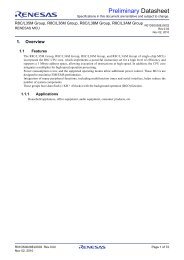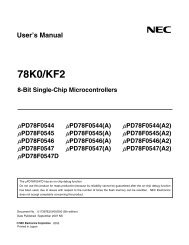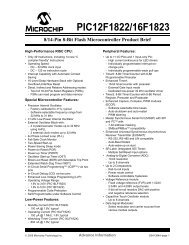xmega a3u - Elfa
xmega a3u - Elfa
xmega a3u - Elfa
You also want an ePaper? Increase the reach of your titles
YUMPU automatically turns print PDFs into web optimized ePapers that Google loves.
XMEGA A3U<br />
15. I/O Ports<br />
15.1 Features<br />
• 50 general purpose input and output pins with individual configuration<br />
• Output driver with configurable driver and pull settings:<br />
– Totem-pole<br />
– Wired-AND<br />
–Wired-OR<br />
– Bus-keeper<br />
– Inverted I/O<br />
• Input with synchronous and/or asynchronous sensing with interrupts and events<br />
– Sense both edges<br />
– Sense rising edges<br />
– Sense falling edges<br />
– Sense low level<br />
• Optional pull-up and pull-down resistor on input and Wired-OR/AND configurations<br />
• Optional slew rate control<br />
• Asynchronous pin change sensing that can wake the device from all sleep modes<br />
• Two port interrupts with pin masking per I/O port<br />
• Efficient and safe access to port pins<br />
– Hardware read-modify-write through dedicated toggle/clear/set registers<br />
– Configuration of multiple pins in a single operation<br />
– Mapping of port registers into bit-accessible I/O memory space<br />
• Peripheral clocks output on port pin<br />
• Real-time counter clock output to port pin<br />
• Event channels can be output on port pin<br />
• Remapping of digital peripheral pin functions<br />
– Selectable USART, SPI, and timer/counter input/output pin locations<br />
15.2 Overview<br />
One port consists of up to eight port pins: pin 0 to 7. Each port pin can be configured as input or<br />
output with configurable driver and pull settings. They also implement synchronous and asynchronous<br />
input sensing with interrupts and events for selectable pin change conditions.<br />
Asynchronous pin-change sensing means that a pin change can wake the device from all sleep<br />
modes, included the modes where no clocks are running.<br />
All functions are individual and configurable per pin, but several pins can be configured in a single<br />
operation. The pins have hardware read-modify-write (RMW) functionality for safe and<br />
correct change of drive value and/or pull resistor configuration. The direction of one port pin can<br />
be changed without unintentionally changing the direction of any other pin.<br />
The port pin configuration also controls input and output selection of other device functions. It is<br />
possible to have both the peripheral clock and the real-time clock output to a port pin, and available<br />
for external use. The same applies to events from the event system that can be used to<br />
synchronize and control external functions. Other digital peripherals, such as USART, SPI, and<br />
timer/counters, can be remapped to selectable pin locations in order to optimize pin-out versus<br />
application needs.<br />
The notation of the ports are PORTA, PORTB, PORTC, PORTD, PORTE, PORTF and PORTR.<br />
8386B–AVR–12/11<br />
30

















